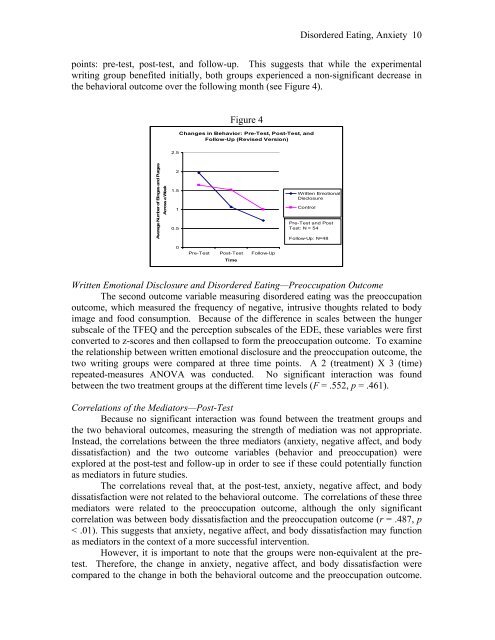The Secret Society: Descendants of Crypto-Jews in the San Antonio ...
The Secret Society: Descendants of Crypto-Jews in the San Antonio ...
The Secret Society: Descendants of Crypto-Jews in the San Antonio ...
Create successful ePaper yourself
Turn your PDF publications into a flip-book with our unique Google optimized e-Paper software.
Disordered Eat<strong>in</strong>g, Anxiety 10<br />
po<strong>in</strong>ts: pre-test, post-test, and follow-up. This suggests that while <strong>the</strong> experimental<br />
writ<strong>in</strong>g group benefited <strong>in</strong>itially, both groups experienced a non-significant decrease <strong>in</strong><br />
<strong>the</strong> behavioral outcome over <strong>the</strong> follow<strong>in</strong>g month (see Figure 4).<br />
Figure 4<br />
Changes <strong>in</strong> Behavior: Pre-Test, Post-Test, and<br />
Follow-Up (Revised Version)<br />
2.5<br />
Average Number <strong>of</strong> B<strong>in</strong>ges and Purges<br />
Across a Week<br />
2<br />
1.5<br />
1<br />
0.5<br />
Written Emotional<br />
Disclosure<br />
Control<br />
Pre-Test and Post<br />
Test: N = 54<br />
Follow-Up: N=48<br />
0<br />
Pre-Test Post-Test Follow-Up<br />
Time<br />
Written Emotional Disclosure and Disordered Eat<strong>in</strong>g—Preoccupation Outcome<br />
<strong>The</strong> second outcome variable measur<strong>in</strong>g disordered eat<strong>in</strong>g was <strong>the</strong> preoccupation<br />
outcome, which measured <strong>the</strong> frequency <strong>of</strong> negative, <strong>in</strong>trusive thoughts related to body<br />
image and food consumption. Because <strong>of</strong> <strong>the</strong> difference <strong>in</strong> scales between <strong>the</strong> hunger<br />
subscale <strong>of</strong> <strong>the</strong> TFEQ and <strong>the</strong> perception subscales <strong>of</strong> <strong>the</strong> EDE, <strong>the</strong>se variables were first<br />
converted to z-scores and <strong>the</strong>n collapsed to form <strong>the</strong> preoccupation outcome. To exam<strong>in</strong>e<br />
<strong>the</strong> relationship between written emotional disclosure and <strong>the</strong> preoccupation outcome, <strong>the</strong><br />
two writ<strong>in</strong>g groups were compared at three time po<strong>in</strong>ts. A 2 (treatment) X 3 (time)<br />
repeated-measures ANOVA was conducted. No significant <strong>in</strong>teraction was found<br />
between <strong>the</strong> two treatment groups at <strong>the</strong> different time levels (F = .552, p = .461).<br />
Correlations <strong>of</strong> <strong>the</strong> Mediators—Post-Test<br />
Because no significant <strong>in</strong>teraction was found between <strong>the</strong> treatment groups and<br />
<strong>the</strong> two behavioral outcomes, measur<strong>in</strong>g <strong>the</strong> strength <strong>of</strong> mediation was not appropriate.<br />
Instead, <strong>the</strong> correlations between <strong>the</strong> three mediators (anxiety, negative affect, and body<br />
dissatisfaction) and <strong>the</strong> two outcome variables (behavior and preoccupation) were<br />
explored at <strong>the</strong> post-test and follow-up <strong>in</strong> order to see if <strong>the</strong>se could potentially function<br />
as mediators <strong>in</strong> future studies.<br />
<strong>The</strong> correlations reveal that, at <strong>the</strong> post-test, anxiety, negative affect, and body<br />
dissatisfaction were not related to <strong>the</strong> behavioral outcome. <strong>The</strong> correlations <strong>of</strong> <strong>the</strong>se three<br />
mediators were related to <strong>the</strong> preoccupation outcome, although <strong>the</strong> only significant<br />
correlation was between body dissatisfaction and <strong>the</strong> preoccupation outcome (r = .487, p<br />
< .01). This suggests that anxiety, negative affect, and body dissatisfaction may function<br />
as mediators <strong>in</strong> <strong>the</strong> context <strong>of</strong> a more successful <strong>in</strong>tervention.<br />
However, it is important to note that <strong>the</strong> groups were non-equivalent at <strong>the</strong> pretest.<br />
<strong>The</strong>refore, <strong>the</strong> change <strong>in</strong> anxiety, negative affect, and body dissatisfaction were<br />
compared to <strong>the</strong> change <strong>in</strong> both <strong>the</strong> behavioral outcome and <strong>the</strong> preoccupation outcome.
















